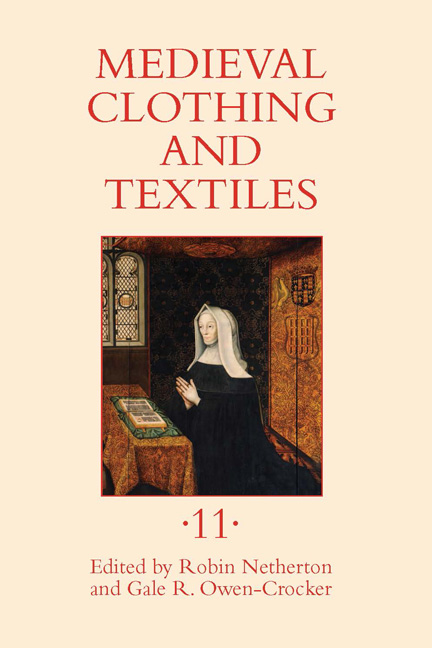Book contents
- Frontmatter
- Contents
- Illustrations
- Tables
- Contributors
- Preface
- 1 Production, Quality, and Social Status in Viking Age Dress: Three Cases from Western Norway
- 2 The Effect of Spindle Whorl Design on Wool Thread Production: A Practical Experiment Based on Examples from Eighth-Century Denmark
- 3 The Shirt Attributed to St. Louis
- 4 Angevin-Sicilian Sumptuary Statutes of the 1290s: Fashion in the Thirteenth-Century Mediterranean
- 5 The Devil on My Tail: Clothing and Visual Culture in the Camposanto Last Judgment
- 6 “Transposing þe shapus þat God first mad them of”: Manipulated Masculinity in the Galaunt Tradition
- 7 Textiles and Dress in the Household Papers of Lady Margaret Beaufort (1443–1509), Mother of King Henry VII
- 8 “Like two artificial gods”: Needlework and Female Bonding in A Midsummer Night's Dream
- Recent Books of Interest
- Contents of Previous Volumes
8 - “Like two artificial gods”: Needlework and Female Bonding in A Midsummer Night's Dream
Published online by Cambridge University Press: 05 December 2015
- Frontmatter
- Contents
- Illustrations
- Tables
- Contributors
- Preface
- 1 Production, Quality, and Social Status in Viking Age Dress: Three Cases from Western Norway
- 2 The Effect of Spindle Whorl Design on Wool Thread Production: A Practical Experiment Based on Examples from Eighth-Century Denmark
- 3 The Shirt Attributed to St. Louis
- 4 Angevin-Sicilian Sumptuary Statutes of the 1290s: Fashion in the Thirteenth-Century Mediterranean
- 5 The Devil on My Tail: Clothing and Visual Culture in the Camposanto Last Judgment
- 6 “Transposing þe shapus þat God first mad them of”: Manipulated Masculinity in the Galaunt Tradition
- 7 Textiles and Dress in the Household Papers of Lady Margaret Beaufort (1443–1509), Mother of King Henry VII
- 8 “Like two artificial gods”: Needlework and Female Bonding in A Midsummer Night's Dream
- Recent Books of Interest
- Contents of Previous Volumes
Summary
Lo, she is one of this confederacy.
Now I perceive they have conjoined all three
To fashion this false sport, in spite of me.—
Injurious Hermia, most ungrateful maid,
Have you conspired, have you with these contrived
To bait me with this foul derision?
Is all the counsel that we two have shared—
The sisters’ vows, the hours that we have spent,
When we have chid the hasty-footed time
For parting us.—O, is it all forgot?
All schooldays' friendship, childhood innocence?
We, Hermia, like two artificial gods,
Have with our needles created both one flower,
Both on one sampler, sitting on one cushion,
Both warbling of one song, both in one key,
As if our hands, our sides, voices and minds,
Had been incorporate. So we grew together,
Like to a double cherry: seeming parted,
But yet an union in partition,
Two lovely berries moulded on one stem.
So, with two seeming bodies, but one heart,
Two of the first—like coats in heraldry,
Due but to one and crowned with one crest.
And will you rend our ancient love asunder,
To join with men in scorning your poor friend?
It is not friendly, 'tis not maidenly.
Our sex, as well as I, may chide you for it,
Though I alone do feel the injury.
A Midsummer Night's Dream (3.2.193–220)In her speech to Hermia in act 3, scene 2 of A Midsummer Night's Dream, Helena seeks to reclaim Hermia's friendship by recreating a scene of their childhood bonding and by evoking needlework objects associated with intimacy and femininity. An inquiry into Helena's rhetorical strategies in this speech is incomplete without recognition of its investment in material culture that, as Karen Harvey defines it, “encapsulates not just the physical attributes of an object, but the myriad and shifting contexts through which it acquires meaning.” The object, in turn, becomes a meaning-making conduit through which characters are able to process and express their thoughts and emotions.
- Type
- Chapter
- Information
- Medieval Clothing and Textiles 11 , pp. 159 - 178Publisher: Boydell & BrewerPrint publication year: 2015



